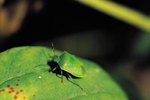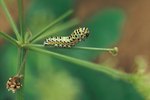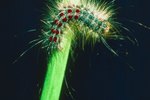
The sound of grasshoppers brings to mind warm, lazy summer days spent lying in long grass for most of us; but among farmers, grasshoppers and locusts have a more sinister reputation as crop-destroyers. Most short-horned grasshoppers and all locusts belong the same family, Acrididae, and are very similar insects. Locusts differ mostly in their ability to change appearance and behavior in response to population increases and reduction in food supplies. Long-horned grasshoppers, or katydids, also look similar, but are members of the Tettigoniidae family.
Grasshoppers
Grasshoppers share many features with other insects, including six legs, a separate head, abdomen and thorax, and a hard, chitinous shell. Different species range in size between 1/2 inch and 2 3/4 inches, or 7 centimeters. Grasshoppers have long hind legs, large eyes, a single pair of antennae, and two pairs of wings. Their front wings are thin and tough, and their back wings are wide and flexible. In some species the wings are brightly colored, but most grasshoppers' coloring is green, brown or gray, to help them blend into their environment. Grasshoppers also have large mouthparts for chewing. Long-horned grasshoppers' identifying characteristic is their antennae, which are longer than their wings, while short-horned grasshoppers have short, stubby antennae.
Locusts
Locust bodies undergo changes when they turn from solitary to swarming behavior. Their wings grow larger, enabling them to fly great distances; some species change color or appearance. Migratory locusts' (Locusta migratoria) heads become more streamlined, and desert locusts (Schistocerca gregaria) change from green to black with orange spots. Locusts have two phases, solitary and swarming. Female locusts are larger than males when species are in the solitary phase; but when they're swarming, size differences reduce and sometimes disappear entirely. Most grasshoppers look similar as they grow, increasing in size in five or six stages, gaining wings in their final, adult stage.
Social Behavior
Grasshoppers and locusts have different patterns of social behavior that can help identify them. A single insect could be a grasshopper or a locust, but a band of insects in close proximity to one another are almost certainly locusts. Grasshoppers tend to be solitary insects, only meeting others to mate and reproduce. Locusts are solitary only sometimes. They change from solitary to gregarious or swarming when their populations achieve a certain density, and often if surrounding vegetation becomes dry. Instead of avoiding each other, they seek out other locusts and complete they daily activities of feeding, basking, moving and roosting in groups or bands.
Migration
Grasshoppers and locusts are similar in their preferences for specific habitats, but locusts range widely, migrating to different areas. Most grasshoppers remain roughly where they hatched, living in open, dry grassland and scrub, and also often invading adjacent farmers' fields. When swarming, locusts travel large distances in bands and also fly long distances when solitary. The Food and Agriculture Organization of the United Nations' guidelines on desert locusts states crawling locusts have been recorded traveling 650 feet to 5,500 feet. Solitary locusts may fly 870 miles in one day.
References
- Food and Agriculture Organization of the United Nations: Desert Locust Guidelines
- New Mexico State University: General Morphology & Biology of Grasshoppers
- Food and Agriculture Organization of the United Nations: More About locusts
- Biokids: Grasshoppers
- Harvard University Department of Entymology: Tettigoniidae (Katydids or Long-Horned Grasshoppers)
Resources
Photo Credits
-
Stockbyte/Stockbyte/Getty Images
Writer Bio
A graduate of Leeds University, Jenny Green completed Master of Arts in English literature in 1998 and has been writing about travel, gardening, science and pets since 2007. Green's work appears in Diva, Whole Life Times, Listverse, Earthtimes, Lamplight, Stupefying Stories and other websites and magazines.




